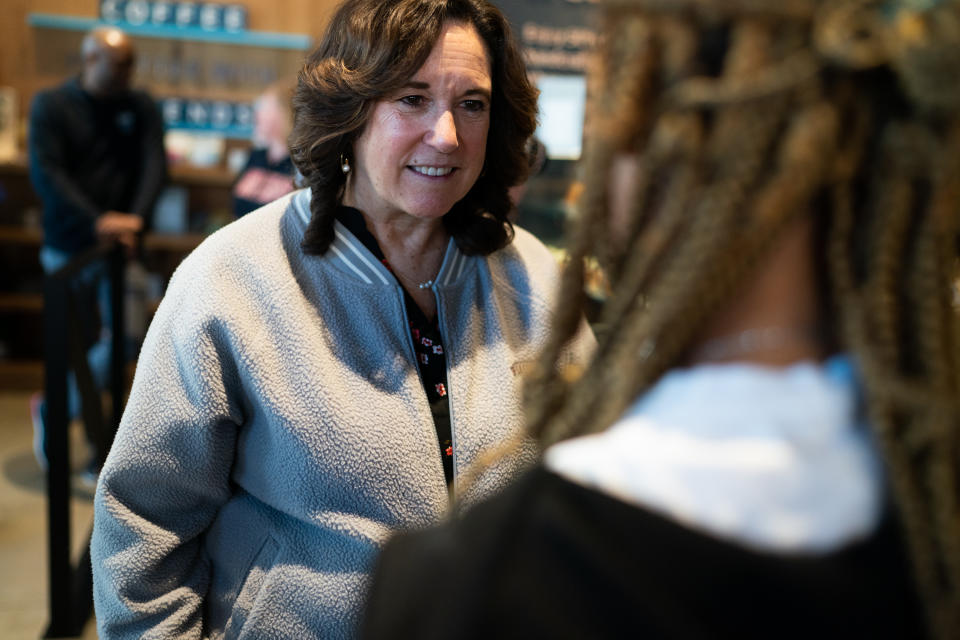With college decisions looming, students ask: What’s the cost, really?
- Oops!Something went wrong.Please try again later.
In an Anacostia coffee shop packed with high school seniors desperate to know how much financial aid they might receive for college, Donnell Washington let a small group know they would have to wait for answers.
“Everything is delayed this year,” Washington, who works for a college prep program, told the students. “It will be May, June before you hear.”
“Colleges can’t tell us how much it costs to attend till they get our FAFSA,” Aaron Mengesha, a 17-year-old from Silver Spring, Md., said, referring to the form Federal Student Aid, an office of the U.S. Department of Education, uses to calculate a student’s eligibility for grants and loans to pay for college.
“How can we make a decision?” his twin brother, Ezra Mengesha, asked. “I have to make a commitment in early May. How will I know how much I will get?”
Washington was blunt: “You just won’t.”
Ezra dropped his head into his hand. He had been accepted at the University of Maryland and was waiting to hear from Columbia University. The financial aid packages colleges offer are central to the twins’ decisions this spring. Their parents had already helped their older sister pay for college. Now, the family is facing double tuition for the next four years.
Students across the country this spring are confronting one of the most momentous decisions of their lives without an answer to a fundamental question: How much will college cost? The federal government’s lifeline of aid to low- and middle-income students has been mired in bureaucratic delays that leave aspirational students without the information they desperately need. Amid a national debate over college admissions in the wake of a landmark Supreme Court ruling rejecting race-based affirmative action, the issue of affordability is a crucible.
And the government isn’t helping.
“This is crunch time,” Kim Cook, chief executive of the National College Attainment Network (NCAN), said at that packed event at the Capital One Cafe in the Anacostia area of D.C. on a recent Saturday. Staff members from College Success Foundation District of Columbia, like Washington, were helping anxious students fill out forms and answering questions - as much as they could, with the delayed and botched rollout of the FAFSA.
“They’re getting their acceptance offers from universities,” Cook said. “But they’re not getting the aid offers.”
College hopefuls face a grim realization that despite their best efforts to complete every step toward enrollment - filling out applications, writing personal essays, applying for financial aid - the federal government has thrown up roadblocks. Severe delays in the Education Department processing the newly updated Free Application for Federal Student Aid have prevented colleges from issuing financial aid offers that students need to decide where to enroll.
Even as the department has ramped up the transmission of financial aid data to colleges, schools say it is a slow-going process. Some colleges have extended their traditional dates when students must commit to attend, an acknowledgment of the extreme disruption nationally. But many schools still require students to adhere to strict deadlines.
Meanwhile, some students are still trying to submit the financial aid form, which remains beset by technical glitches.
The problem is much more than paperwork: Higher education experts worry the delays and problems with the form will discourage students from enrolling in college this year, especially those from underserved communities.
“That is a crisis,” Angel Pérez, chief executive of the National Association for College Admission Counseling, said in a recent phone interview. “We could see another major drop-off in the pipeline of students to college, like we did during covid - and that’s a direct pipeline into the workforce, as well. So I’m quite worried about that.”
An analysis of department data by NCAN found that as of March 8, FAFSA completions among high school seniors are down 33 percent from the same period a year ago. Submissions, which the group says is a key predictor of whether a high school senior heads to college, are especially tepid at schools with high percentages of Black, Latino and low-income students.
Cook suspects some of the decline at those schools is the result of a flaw in the new form that has prevented U.S.-born students with undocumented parents from completing the FAFSA. Parents without a Social Security number have been locked out of the application since it debuted on Dec. 30. Last week, the Education Department announced two technical fixes but said separate but related problems still need to be resolved. Cook said she hopes the resolutions will result in an uptick in submissions.
This FAFSA cycle has become a painful test of a new financial aid system that higher education experts agree will ultimately deliver more money for millions of students to pay for college. Three years ago, Congress directed the Education Department to reduce the number of questions on the financial aid form and increase the amount of income shielded from a formula used to determine aid eligibility. The changes will ensure more students receive the Pell Grant, a form of aid for undergraduates with exceptional financial need. And a streamlined application that now allows families to easily import their tax data into the form means students can ideally breeze through the form.
“We have 5.8 million FAFSAs filled out now,” said U.S. Deputy Secretary of Education Cindy Marten, who stopped by the event in Anacostia. “I just talked to 10 kids who are part of that 5.8 million to hear their personal story of what the experience was like.” She said students were telling her the form was easy and fast to fill out.
But filling out the form is only one step.
A stressful process has become even more stressful this year, said Kevin Mungin, director of programs for the College Success Foundation. Surrounded by students typing on laptops and talking with staff members, he said everyone keeps asking how long it will take the government to process their forms, then how long it will take the colleges to process the information, then how long until they get letters with their financial aid offers. The hardest part, he said, is trying to keep students and parents calm “even though you’re talking about your future.”
More than 100 students showed up that day to drill into financial aid. Some needed help logging in to the federal system. Some had questions about the form. Some needed information about applying for scholarships or D.C. Tuition Assistance Grants. The College Success Foundation plans to be there March 30 in the same spot. And Capital One is hosting similar events nationally this spring.
Next month, the department is hosting a “week of action” to get the word out that all high school seniors should have completed a FAFSA. “I’d love to see more community-sponsored events like this, where kids come together on a Saturday with adult support and peer support,” Marten said. “They’ve got their laptops open, they’re scrolling through things, they’re asking questions.”
In one room, Washington and two of his colleagues were helping students try to estimate costs without the crucial federal information. “You don’t know how much Student Aid is giving you,” he said. “But what you can do is list out how much it will cost you to attend the universities” without financial aid.
Students can apply for scholarships now, he said, with help from an app that provides links to grants in the academic area they’re interested in.
“You need to be filling out a scholarship form every day,” he urged them. “You’ve got to go chase it.”
He told them schools can’t give them a precise aid offer until they have the federal data. Then the students will finally know how much it will cost them to go to that college. If they need to correct something on the form, they need to do it as soon as possible, to avoid further delays, he said.
But they can’t do that yet; the government has said the system can’t handle it, he said.
“It’s very confusing,” a student said.
The staff members nodded.
Washington told them to talk with the adults in their lives and vent: “Just lay it all out there. Because it’s a lot. … You’re still trying to graduate, and you’ve got all this other stuff. … It’s crazy. This is across America.”
Betty Wonde, an 18-year-old senior at Paint Branch High School in Maryland, hadn’t filled out the form before arriving at the event. Her older sister told her it was complicated and she would definitely need guidance to get through it. Wonde has been accepted with scholarships to the University of Maryland and Hope College. She is waiting to hear from Tufts University, Boston College and others.
She’s planning to study neuroscience and global affairs next year - after she gets through the FAFSA.
It was nerve-racking to fill out the form, said Selam Demeke, an 18-year-old senior at Justice High School in Virginia. “I was afraid I’d make some mistake - or translate something wrong for my father,” she said. Her parents came to the United States from Ethiopia in 2006 to give their children better educational opportunities. Like some other students at the event, she had learned of it through the African Diaspora College Access Program.
Demeke will be going to Brown University in the fall with tuition, room and board paid for by the school through a partnership with QuestBridge, a nonprofit that helps connect high-achieving students from low-income backgrounds with colleges. But she is hoping for aid to help her get to the campus and cover other personal expenses. She said her father is a taxi driver, her mother is unemployed and she comes from a family of six.
“That was super helpful,” Aaron Mengesha said as the event ended. He has been worried about how to pay for college and was happy to have gotten into U-Md. because it has in-state tuition and a strong engineering program. He filled out the FAFSA as soon as the form became available. “I’m hoping for a lot of aid,” he said.
“It’s unfortunate there’s a delay,” his brother said. “I’ve got to make my decision without knowing the biggest burden - price.”
Related Content
Abortions outside medical system increased sharply after Roe fell, study finds
Putting chaplains in public school is the latest battle in culture wars
After voting to legalize weed, Marylanders are mixed on impact, poll finds





